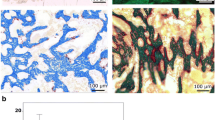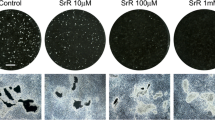Abstract
Various bone resorption inhibitors and bone stimulators have been shown to decrease the risk of osteoporotic fractures. However, there is still a need for agents promoting bone formation by inducing positive uncoupling between bone formation and bone resorption. In vitro studies have suggested that strontium ranelate enhances osteoblast cell replication and activity. Simultaneously, strontium ranelate dose-dependently inhibits osteoclast activity. In vivo studies indicate that strontium ranelate stimulates bone formation and inhibits bone resorption and prevents bone loss and/or promotes bone gain. This positive uncoupling between bone formation and bone resorption results in bone gain and improvement in bone geometry and microarchitecture, without affecting the intrinsic bone tissue quality. Thus, all the determinants of bone strength are positively influenced. In conclusion, strontium ranelate, a new treatment of postmenopausal osteoporosis, acts through an innovative mode of action, both stimulating bone formation and inhibiting bone resorption, resulting in the rebalancing of bone turnover in favor of bone formation. Strontium ranelate increases bone mass while preserving the bone mineralization process, resulting in improvement in bone strength and bone quality.
Similar content being viewed by others
References
Meunier PJ, Roux C, Seeman E, Ortolani S, Badurski JE, Spector TD, Cannata J, Balogh A, Lemmel EM, Pors-Nielsen S, Rizzoli R, Genant HK, Reginster JY (2004) The effects of strontium ranelate on the risk of vertebral fracture in women with postmenopausal osteoporosis. N Engl J Med 350:459–468
Rizzoli R, Reginster JY, Diaz-Curiel M et al (2004) Patients at high risk of hip fracture benefit from treatment with strontium ranelate. Osteoporos Int 15(S1):OC39
Ammann P, Rizzoli R, Bonjour JP (1998) Preclinical evaluation of new therapeutic agents for osteoporosis. In: Meunier PJ (ed) Osteoporosis: diagnosis and management. Martin Dunitz, London, pp 257–273
Ammann P, Rizzoli R, Bonjour JP (1998) Protein malnutrition-induced bone loss is associated with alteration of growth hormone-IGF-I axis and with estrogen deficiency in adult rats. Osteoporos Int 8(S3):10
Bonjour JP, Ammann P, Rizzoli R (1999) Importance of preclinical studies in the development of drugs for treatment of osteoporosis: a review related to the 1998 WHO guidelines. Osteoporos Int 9:379–293
Rho JY, Tsui YT, Pharr GM (1997) Elastic properties of human cortical and trabecular lamellar bone measured by nanoindentation. Biomaterials 18/20:1325–1330
Zysset PK, Guo XE, Hoffler CE, Moore KE, Goldstein SA (1999) Elastic modulus and hardness of cortical and trabecular bone lamellae measured by nanoindentation in the human femur. J Biomech 32:1005–1012
Roy ME, Rho JY, Tsui YT, Evans NS, Pharr GM (1999) Mechanical and morphological variation of the human lumbar vertebral cortical and trabecular bone. J Biomed Mater Res 44:191–199
Hoffler CE, Moore KE, Kozloff K, Zysset PK, Brown MB, Goldstein SA (2000) Heterogeneity of bone lamellar-level elastic moduli. Bone 26:603–609
Hoffler CE, Moore KE, Kozloff K, Zysset PK, Goldstein SA (2000) Age, gender, and bone lamellae elastic moduli. J Orthop Res 18:432–437
Hengsberger S, Boivin G, Zysset PK (2002) Morphological and mechanical properties of bone structural units: a two-case study. JSME Series C 45/4:936–43
Ettinger B, Black DM, Mitlak BH, Knickerbocker RK, Nickelsen T, Genant HK, Christiansen C, Delmas PD, Zanchetta JR, Stakkestad J, Gluer CC, Krueger K, Cohen FJ, Eckert S, Ensrud KE, Avioli LV, Lips P, Cummings SR (1999) Reduction of vertebral fracture risk in postmenopausal women with osteoporosis treated with raloxifene: results from a 3-year randomized clinical trial. Multiple Outcomes of Raloxifene Evaluation (MORE) Investigators. JAMA 282:637–645
Riggs BL, Khosla S, Melton LJ 3rd (2002) Sex steroids and the construction and conservation of the adult skeleton. Endocr Rev 23:279–302
Hochberg MC, Greenspan S, Wasnich RD, Miller P, Thompson DE, Ross PD (2002) Changes in bone density and turnover explain the reductions in incidence of nonvertebral fractures that occur during treatment with antiresorptive agents. J Clin Endocrinol Metab 87:1586–1592
Liberman UA, Weiss SR, Broll J, Minne HW, Quan H, Bell NH, Rodriguez-Portales J, Downs RW Jr, Dequeker J, Favus M (1995) Effect of oral alendronate on bone mineral density and the incidence of fractures in postmenopausal osteoporosis. The Alendronate Phase III Osteoporosis Treatment Study Group. N Engl J Med 333:1437–1443
Black DM, Cummings SR, Karpf DB, Cauley JA, Thompson DE, Nevitt MC, Bauer DC, Genant HK, Haskell WL, Marcus R, Ott SM, Torner JC, Quandt SA, Reiss TF, Ensrud KE (1996) Randomised trial of effect of alendronate on risk of fracture in women with existing vertebral fractures. Fracture Intervention Trial Research Group. Lancet 348:1535–1541
Delmas PD, Bjarnason NH, Mitlak BH, Ravoux AC, Shah AS, Huster WJ, Draper M, Christiansen C (1997) Effects of raloxifene on bone mineral density, serum cholesterol concentrations, and uterine endometrium in postmenopausal women. N Engl J Med 337:1641–1647
Bourrin S, Ammann P, Bonjour JP, Rizzoli R (2002) Recovery of proximal tibia bone mineral density and strength, but not cancellous bone architecture, after long-term bisphosphonate or selective estrogen receptor modulator therapy in aged rats. Bone 30:195–200
Chavassieux PM, Arlot ME, Reda C, Wei L, Yates AJ, Meunier PJ (1997) Histomorphometric assessment of the long-term effects of alendronate on bone quality and remodeling in patients with osteoporosis. J Clin Invest 100:1475–1480
Meunier PJ, Boivin G (1997) Bone mineral density reflects bone mass but also the degree of mineralization of bone: therapeutic implications. Bone 21:373–377
Boivin GY, Chavassieux PM, Santora AC, Yates J, Meunier PJ (2000) Alendronate increases bone strength by increasing the mean degree of mineralization of bone tissue in osteoporotic women. Bone 27:687–694
Garnero P, Delmas PD (1996) New developments in biochemical markers for osteoporosis. Calcif Tissue Int 59 [Suppl 1]:S2–9
Pak CY, Sakhaee K, Zerwekh JE, Parcel C, Peterson R, Johnson K (1989) Safe and effective treatment of osteoporosis with intermittent slow release sodium fluoride: augmentation of vertebral bone mass and inhibition of fractures. J Clin Endocrinol Metab 68:150–159
Hedlund LR, Gallagher JC (1989) Increased incidence of hip fracture in osteoporotic women treated with sodium fluoride. J Bone Miner Res 4:223–225
Schnitzler CM, Wing JR, Gear KA, Robson HJ (1990) Bone fragility of the peripheral skeleton during fluoride therapy for osteoporosis. Clin Orthop:268–275
Riggs BL, Hodgson SF, O’Fallon WM, Chao EY, Wahner HW, Muhs JM, Cedel SL, Melton LJ 3rd (1990) Effect of fluoride treatment on the fracture rate in postmenopausal women with osteoporosis. N Engl J Med 322:802–809
Pouilles JM, Tremollieres F, Causse E, Louvet JP, Ribot C (1991) Fluoride therapy in postmenopausal osteopenic women: effect on vertebral and femoral bone density and prediction of bone response. Osteoporos Int 1:103–109
Turner CH, Owan I, Brizendine EJ, Zhang W, Wilson ME, Dunipace AJ (1996) High fluoride intakes cause osteomalacia and diminished bone strength in rats with renal deficiency. Bone 19:595–601
Meunier PJ, Sebert JL, Reginster JY, Briancon D, Appelboom T, Netter P, Loeb G, Rouillon A, Barry S, Evreux JC, Avouac B, Marchandise X (1998) Fluoride salts are no better at preventing new vertebral fractures than calcium-vitamin D in postmenopausal osteoporosis: the FAVOStudy. Osteoporos Int 8:4–12
Jorgensen PH, Bak B, Andreassen TT (1991) Mechanical properties and biochemical composition of rat cortical femur and tibia after long-term treatment with biosynthetic human growth hormone. Bone 12:353–359
Ammann P, Rizzoli R, Muller K, Slosman D, Bonjour JP (1993) IGF-I and pamidronate increase bone mineral density in ovariectomized adult rats. Am J Physiol 265:E770–E776
Ammann P, Rizzoli R, Meyer JM, Bonjour JP (1996) Bone density and shape as determinants of bone strength in IGF-I and/or pamidronate-treated ovariectomized rats. Osteoporos Int 6:219–227
Oxlund H, Ejersted C, Andreassen TT, Torring O, Nilsson MH (1993) Parathyroid hormone (1–34) and (1–84) stimulate cortical bone formation both from periosteum and endosteum. Calcif Tissue Int 53:394–399
Ejersted C, Andreassen TT, Oxlund H, Jorgensen PH, Bak B, Haggblad J, Torring O, Nilsson MH (1993) Human parathyroid hormone (1–34) and (1–84) increase the mechanical strength and thickness of cortical bone in rats. J Bone Miner Res 8:1097–1101
Mosekilde L, Danielsen CC, Gasser J (1994) The effect on vertebral bone mass and strength of long-term treatment with antiresorptive agents (estrogen and calcitonin), human parathyroid hormone-(1–38), and combination therapy, assessed in aged ovariectomized rats. Endocrinology 134:2126–2134
Mosekilde L, Sogaard CH, McOsker JE, Wronski TJ (1994) PTH has a more pronounced effect on vertebral bone mass and biomechanical competence than antiresorptive agents (estrogen and bisphosphonate)—assessed in sexually mature, ovariectomized rats. Bone 15:401–408
Li M, Wronski TJ (1995) Response of femoral neck to estrogen depletion and parathyroid hormone in aged rats. Bone 16:551–557
Andreassen TT, Jorgensen PH, Flyvbjerg A, Orskov H, Oxlund H (1995) Growth hormone stimulates bone formation and strength of cortical bone in aged rats. J Bone Miner Res 10:1057–1067
Andreassen TT, Oxlund H (2000) The influence of combined parathyroid hormone and growth hormone treatment on cortical bone in aged ovariectomized rats. J Bone Miner Res 15:2266–2275
Toromanoff A, Ammann P, Riond JL (1998) Early effects of short-term parathyroid hormone administration on bone mass, mineral content, and strength in female rats. Bone 22:217–223
Bonjour JP, Chevalley T, Ammann P, Slosman D, Rizzoli R (2001) Gain in bone mineral mass in prepubertal girls 3.5 years after discontinuation of calcium supplementation: a follow-up study. Lancet 358:1208–1212
Canalis E, Hott M, Deloffre P, Tsouderos Y, Marie PJ (1996) The divalent strontium salt S12911 enhances bone cell replication and bone formation in vitro. Bone 18:517–523
Baron R, Tsouderos Y (2002) In vitro effects of S12911–2 on osteoclast function and bone marrow macrophage differentiation. Eur J Pharmacol 450:11–17
Takahashi N, Sasaki T, Tsouderos Y, Suda T (2003) S 12911–2 inhibits osteoclastic bone resorption in vitro. J Bone Miner Res 18:1082–1087
Delannoy P, Bazot D, Marie PJ (2002) Long-term treatment with strontium ranelate increases vertebral bone mass without deleterious effect in mice. Metabolism 51:906–911
Grynpas MD, Hamilton E, Cheung R, Tsouderos Y, Deloffre P, Hott M, Marie PJ (1996) Strontium increases vertebral bone volume in rats at a low dose that does not induce detectable mineralization defect. Bone 18:253–259
Marie PJ, Hott M, Modrowski D, De Pollak C, Guillemain J, Deloffre P, Tsouderos Y (1993): An uncoupling agent containing strontium prevents bone loss by depressing bone resorption and maintaining bone formation in estrogen-deficient rats. J Bone Miner Res 8:607–615
Bain S, Shen V, Hara P, Dupin-Roger I (2003) Long-term treatment with strontium ranelate increases histomorphometric indices of bone formation in ovariectomized rats. J Bone Miner Res 18 [suppl 2]:S277
Hott M, Deloffre P, Tsouderos Y, Marie PJ (2003) S12911–2 reduces bone loss induced by short-term immobilization in rats. Bone 33:115–123
Ammann P, Shen V, Robin B, Mauras Y, Bonjour JP, Rizzoli R (2004) Strontium ranelate improves bone resistance by increasing bone mass and improving architecture in intact female rats. J Bone Miner Res 19(12):2012–2020
Ammann P, Barrauld S, Dayer R, Dupin-Roger I, Rizzoli R (2004) Strontium ranelate increases bone quality in rats: improvement of the microarchitecture and preservation of the intrinsic bone quality. J Bone Miner Res 19 [Suppl 1]:S178
Boivin G, Deloffre P, Perrat B, Panczer G, Boudeulle M, Mauras Y, Tsouderos Y, Meunier PJ (1996), Strontium distribution and interactions with bone mineral in monkey iliac bone after strontium salt (S12911) administration. J Bone Miner Res 11:1302–1311
Author information
Authors and Affiliations
Corresponding author
Rights and permissions
About this article
Cite this article
Ammann, P. Strontium ranelate: A novel mode of action leading to renewed bone quality. Osteoporos Int 16 (Suppl 1), S11–S15 (2005). https://doi.org/10.1007/s00198-004-1809-9
Received:
Accepted:
Published:
Issue Date:
DOI: https://doi.org/10.1007/s00198-004-1809-9




